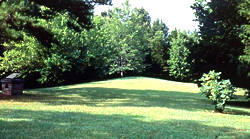 | |
| Location | Ridgeland, Mississippi, Madison County, Mississippi, |
|---|---|
| Region | Madison County, Mississippi |
| Coordinates | 32°27′11.84″N90°4′2.86″W / 32.4532889°N 90.0674611°W |
| History | |
| Cultures | Late Woodland and Early Mississippian period |
| Site notes | |
| Architecture | |
| Architectural styles | burial mounds |
| Architectural details | Number of temples: 6 |
Boyd Mounds Site | |
| Area | 91 acres (37 ha) |
| NRHP reference No. | 89000784 [1] |
| Added to NRHP | July 14, 1989 |
| Responsible body: Private | |

The Boyd Mounds Site (22MD512) is an archaeological site from the Late Woodland and Early Mississippian period located in Madison County, Mississippi near Ridgeland. Many of the mounds were excavated by The National Park Service in 1964. It is located at mile 106.9 on the old Natchez Trace, now the Natchez Trace Parkway. It was added to the NRHP on July 14, 1989 as NRIS number 89000784. [1]
